|
|
Pacman History |
 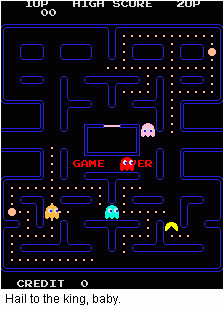 Puckman
Puckman(a.k.a.) Pac-man Arcade release Developer: Namco US publisher: Midway Created by Tohru Iwatani, this was the game which, to coin a phrase, started it all. The hero was named "Puckman" evidently due to his shape. Before its release in the United States, the title was changed to "Pac-man" because "Puckman" was an easy target for vandals to convert into a vulgarity. It introduced the yellow hero along with the four monsters The monsters' original movements were pre-defined at first. People racked up ridiculous scores when their movements were memorized, so a later version of the game gave the monsters more random movement, each with their own personalities. The Red monster is Oikake, "Chaser." This is the monster players will most often find on their tail throughout the game. Nicknamed Akabei, "aka" being Japanese for "red." Also known as Shadow or Inky in the US. The Blue monster is Machibuse, "Ambusher." His strategy is to head toward the opposite end of whatever tunnel Pac is going through. Nicknamed Aosuke, "ao" being Japanese for "blue." Also known as Bashful or Blinky in the US. The Pink monster is Kimagure, "Whimsy." His US name is Speedy, though he's not the fastest monster (Akabei is). He just goes in the general direction Pac is located. Nicknamed "Pinky" in both Japan and the US. The Orange monster is Otoboke, "Plays dumb." He goes in random directions that tend to gravitate toward Pac. Nicknamed Guzuta, "gu" being Japanese for "stupid." Also known as Pokey or Clyde in the US. Obviously, the Orange monster was originally meant to be the dumbest of the four, and the Red one was the smartest. The Hanna Barbera producers obviously didn't notice this, making Clyde the LEADER of the four in their cartoon. The original design for Pac-man outside the game is pretty much the same as it is now, except he had a really large Pinnochio-like nose. This was the Japanese design, of course. The US design was COMPLETELY puzzling. I'm not sure how the artists at Midway managed to picture Pac as a little yellow guy with two big feet and a deranged grin on his face.  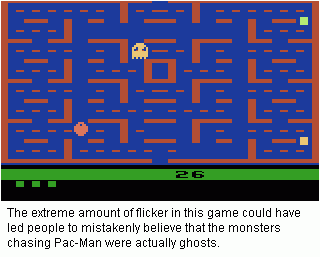 Pac-man
Pac-manAtari 2600 release Developer/US publisher: Atari Probably one of the most infamous arcade translations ever. The 2600 was 4 years old at the time yet this game must have made use of 1% of its abilities. Atari obviously rushed this out as fast as they could to make money off the Pac-man craze. They didn't even give him more than two directions to face. Ms. Pac-man Arcade release Developer/US publisher: Midway Owned by: Namco (acquired the rights in 1982) 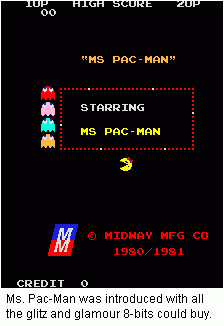 Because Namco has owned the rights to this game since a year after its
initial release, a lot of people make the mistake of thinking they had
anything to do with its production other than making the original game
engine. Nope... not only was this sequel developed in the US, it was
originally created as a hack of the original Pac-man game, named Crazy Otto.
Thing is, unlike other Pac-man hacks, this one did not suck ass, so the
programmers racked up the courage to show it to Midway. Midway liked it,
bought it, made some changes, and the result was Ms. Pac-man.
Because Namco has owned the rights to this game since a year after its
initial release, a lot of people make the mistake of thinking they had
anything to do with its production other than making the original game
engine. Nope... not only was this sequel developed in the US, it was
originally created as a hack of the original Pac-man game, named Crazy Otto.
Thing is, unlike other Pac-man hacks, this one did not suck ass, so the
programmers racked up the courage to show it to Midway. Midway liked it,
bought it, made some changes, and the result was Ms. Pac-man.Despite what was said in the Wayne's World movie, there were more upgrades other than the bow added to the top of Pac's head. They also added an eye AND a mole. =) Plus there are 4 new maze layouts, each with their own color scheme. There are also different fruits, all of which are now able to move around the maze. Finally, there's some new music and some new intermissions. Also, the monsters start going solely by their US nicknames at this point, and after some surgery, Clyde is now known as "Sue." Baby Pac-man is introduced in one of the intermissions, who would eventually star in his own weird-ass game. Midway did not get Namco's permission to release this game. In the end, they decided to give up the rights of this game to Namco to avoid a potential lawsuit. Of course, Midway continued to make unauthorized Pac-man sequels after this, and while none were particularly successful, it did strain the companies' relationship enough for Namco to switch to Atari as its US partner by 1987. 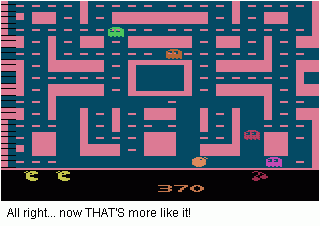 Of Pac-man's many spinoffs and sequels, none have been nearly as successful
as this one. It's one of the two classic machines that can still be found in
almost all of today's arcades, Galaga being the other.
Of Pac-man's many spinoffs and sequels, none have been nearly as successful
as this one. It's one of the two classic machines that can still be found in
almost all of today's arcades, Galaga being the other. Ms. Pac-man Atari 2600 release Developer/US publisher: Atari Unlike its predecessor, Ms. Pac was decently made. Yup.  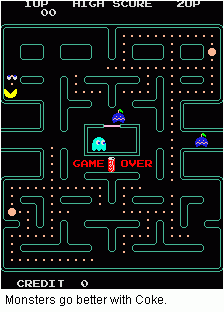 Exciting New Pac-man Plus
Exciting New Pac-man PlusArcade release Developer/US publisher: Midway This was a half-assed "upgrade" to Pac-man offered to arcades by Midway as they waited for Super Pac-man to come in. Essentially the same as Pac-man but with a different color scheme, faster monsters, different fruit, stupid random effects like the maze dissapearing when Pac eats the fruit, and power pellets that didn't work as well as they did before. The game was a big mistake. It wasn't really needed, because people were still playing Ms. Pac, and the gameplay was a step down in just about all respects. Didn't do too well. Most arcade owners restored their "upgrades" back to the original Pac machine pretty quickly. This is one of the few classic arcade games that still is not available on the net in emulated form. Apparently, no one finds this game worth emulating, even for the sake of nostalgia. The only thing I know of that comes close to experiencing this game at home is via a hidden mode in Jess's Pac-mon game. =) Pac-man 5200 release Developer/US publisher: Atari Pac-man 400/800 release Developer/US publisher: Atari The Atari systems that followed the 2600 never did too well, but the arcade translations on these machines WERE pretty top-notch for the time... Super Pac-man Arcade release Developer: Namco US publisher: Bally Midway 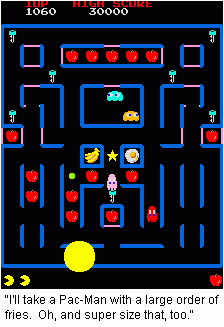 Super Pac-man is the first "True" Pac sequel in the sense that it's the
first one to be developed by its original creator. Namco gave Pac a more
complicated playfield where he had to eat keys to unlock certain parts of
the maze. But they also gave him a new power up that turns him into Super
Pac-man.
Super Pac-man is the first "True" Pac sequel in the sense that it's the
first one to be developed by its original creator. Namco gave Pac a more
complicated playfield where he had to eat keys to unlock certain parts of
the maze. But they also gave him a new power up that turns him into Super
Pac-man.The Super Pellet appears to make Pac grow to a huge size, but Namco's actual intention was to have him FLY above the maze (because he's Super!). Thus while he appears to be moving through the monsters in his Super state, he's actually flying above them. Of course, one has to wonder why he doesn't fly above all the edible items as well... This game was pretty dissappointing overall, with only one maze to navigate and a design that made the first 6 levels too easy and the rest too hard. Plus the whole concept of Pac eating anything but pellets didn't seem right. Most Pac players enjoyed this for a couple weeks, then went back to playing Ms. Pac-man. Mr. & Ms. Pac-man Arcade release Developer/US publisher: Bally Midway continued their attempt to milk Pac for all he's worth by having their Bally partner release a pinball title based on the yellow guy. 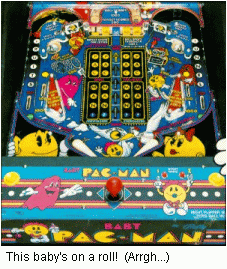 Baby Pac-man
Baby Pac-manArcade release Developer/US publisher: Bally Midway This was one of 2 pinball/console combo games released by Bally Midway. On the console you have the typical pac game where Baby Pac is pitted against the monsters, but the power pellets are missing! Baby Pac can only get these by going through the escape tunnels at the bottom and unlocking pellets via the pinball game. Not a particularly popular game, but kind of a neat concept that was never really tried again until 1999 when Williams kicked off something sort of similar with its Pinball 2000 series of games. |